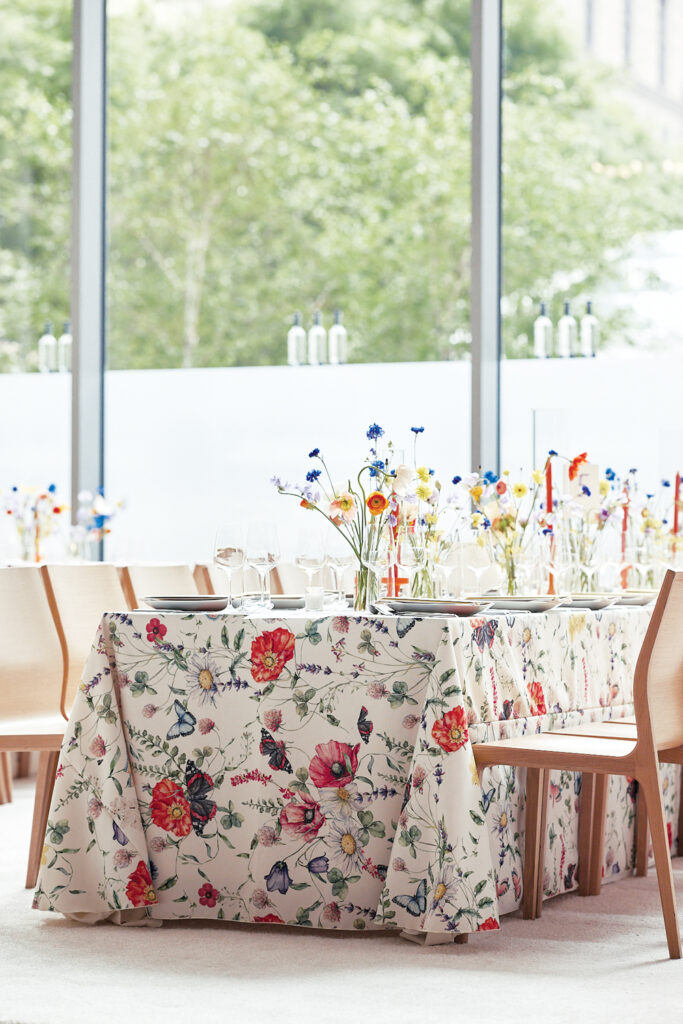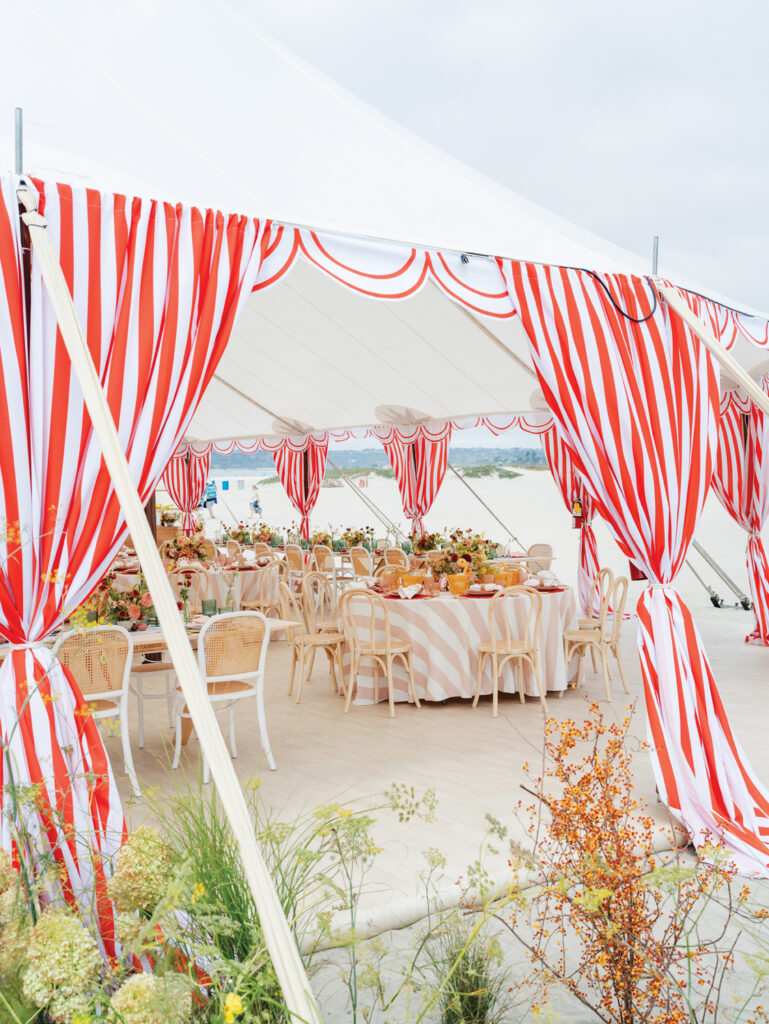
In an era inundated with online inspiration, event planners and their clients are continually seeking new ways to stand out while staying on trend—and they’re increasingly turning to customized linens. When every detail makes a difference, a personalized tablecloth pattern or strategically positioned emblem on a napkin or seat cover can help elevate the entire experience.
Adding these types of custom services is a way for companies to gain a competitive edge. Just ask Jimmy Onello, creative director at A1 Tablecloth, South Hackensack, N.J. After 40 years as a tablecloth supplier, he joined A1 in 2015 and helped establish the linen provider’s in-house digital printing business.
“It’s our fastest-growing segment to this day and gives our customers a new element to their business—a customization service their clients wanted but were unable to receive directly from them,” Onello says.
A1 customer Ideal Tent and Event Rentals, Tea, S.D., attests to this. It added the service in 2018 and it has become progressively more popular for both corporate events and weddings. “Thanks to Pinterest and Instagram, the level of detail our clients are looking for has drastically increased,” says Amy Eckert, marketing and event specialist. “For weddings, especially, things like matching your napkins and drapes to the motif on your invitation wasn’t something people were necessarily doing 20 years ago. But today, that type of request is incredibly common, and I expect it to continue to grow.”
What’s important to note, adds Onello, is that people are looking for more creative ways to get back to basics. “Now, everybody wants more traditional elements—but personalized. And not only tablecloths and napkins—chair covers, stadium seat backs, bar panels, table and aisle runners, you name it.”

What’s less is more
A1 uses dye sublimation printing, effecting a win-win-win situation. “The great thing about digital is it enables you to create a print library without having any inventory. This has created huge savings and convenience for us—and also for our customers,” Onello says. “It’s a quick process to print custom and non-custom patterns on demand, which benefits our customers’ clients as well. We’re all enjoying the same luxury of digital printing—flexibility, which is critical in this industry.”
Liba Fabrics, of New York, N.Y., realized this advantage more recently. The wholesale fabric supplier added in-house dye sublimation printing in early 2021, and it has more than paid off in just a few short years. “Demand has been consistently high, and we’ve grown in two key ways,” says Jacob Visoky, vice president of business development. “One is with existing customers. About 60% of our customer base is geared toward the event industry. Many of these customers, who previously bought only one or two rolls of fabric from us a year, are coming to us more often for custom projects. Printing has also opened the door for us to go into a new avenue of customers. We’re working with more production companies that are doing a lot more corporate events in need of printing and branding. In the past, we were mostly selling them drapes and technical fabrics. But now there’s more opportunity—for both of us.”
With 2 million yards of fabric in stock at any given time, Visoky also appreciates the ability to reduce inventory. “What’s especially nice about doing every print and pattern to order is that we’re much less likely to carry something that’s trending this year and is then out next year.”

Delivering custom on demand
Strategic hiring has been key to Liba’s success, Visoky says. “Printing was brand new to us, so we needed the right personnel from the beginning—people who knew what they were doing and how to speak the language.”
And the learning never stops. The Liba team meets every other week to foster education on new trends and technologies for printing as well as fabrics.
“Printing technology is like the iPhone®,” Onello says. “By the time you get used to it—or at least know how to use all the buttons and features—something new is already out. The first printing machines we bought were single-head machines that printed 10 yards an hour. Two years later, machines were printing double that—and within another year or two, four times that. Now we have machines that are printing 100 yards an hour. And they can run unattended with [transfer] paper.”

With the convenience of high-tech capabilities comes the challenge of managing customer expectations—particularly when it comes to last-minute rush orders or changes to existing jobs. “The hardest part of my job is shuffling the deck every day,” Onello says. “People have grown accustomed to instant gratification. They expect to call you on Monday and get what they want by Wednesday at the latest. And sometimes it’s a tall order. The artwork alone could take hours. You’re fighting the clock all day, every day, but that’s just how it is.”
A1 often receives late-afternoon orders that need to be shipped within just a few hours. An arrangement with UPS helps them accomplish this. Every day, two trailers are parked at A1’s facility: one for purchases and one for rentals. They leave for the shipping distribution center at 8 p.m. every night. “Theoretically, we can get an order at 6 p.m. and cut, sew, fold and pack it in time. But if those trailers don’t get to the distribution center on time, we’ve held back hundreds of orders for one box,” Onello says. “Every day is an adventure—but I wouldn’t have it any other way. We’ve worked with some of the biggest party planners in the world, and I’m excited about the many possibilities that printing will continue to bring to our industry.”
Holly Eamon is a business writer and editor based in Minneapolis, Minn.
SIDEBAR: Striving for sustainability
As customers pursue greater creativity, they’re also advocating for less waste. “People want more than environmentally friendly fabric options. They also want to know what we’re doing to recycle our fabrics or ease the environmental impact of our operations,” says Jacob Visoky, vice president of business development at Liba Fabrics, New York, N.Y. “We’re always looking for ways to reduce waste, but right now, we’re focusing on offering more eco-friendly fabrics we can print on. Unfortunately, price is often a barrier once customers see what these options can cost.”
A1 Tablecloth, South Hackensack, N.J., offers a base cloth made from 100% recycled water bottles that is identical to the company’s standard polyester used for printing. “It’s not growing as fast as we were hoping, but we’re trying to do our part,” says Jimmy Onello, creative director. “All of the paper that goes through the heat press is recycled for other purposes. All of the excess fabric is reused as filler for items like moving blankets and boxing gloves. And we even have a solar-panel roof for our 110,000-square-foot building.”
 TEXTILES.ORG
TEXTILES.ORG


